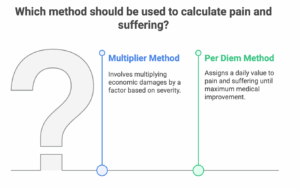Being involved in a car accident is a traumatic experience. Beyond the immediate physical injuries, there’s often a significant amount of emotional distress and disruption to your life. This is what’s commonly referred to as “pain and suffering“, and it’s a legitimate component of the compensation you’re entitled to claim. This guide provides a thorough overview of how to prove these damages and secure the payout you deserve.
Understanding “Pain and Suffering” After a Car Accident: What Are Your Damages?
“Pain and suffering” encompasses both the physical discomfort and emotional distress resulting from an accident. It’s a broad term that acknowledges the impact of injuries extends beyond the purely medical. Think of it as the price you pay for the diminished quality of your life after an accident. This can include:
- Physical Pain: Acute and chronic pain, discomfort, and limitations in movement.
- Emotional Distress: Anxiety, depression, PTSD, fear, grief, and loss of enjoyment of life.
- Mental Anguish: Worry about finances, the future, and your ability to support yourself or your family.
- Loss of Consortium: Affects the relationship with your spouse due to the injuries sustained.

It’s crucial to understand that you’re not just claiming for broken bones, but also for the sleepless nights, the inability to play with your children, and the constant worry that now permeates your life.
Documenting Your Car Accident Injuries: Evidence is Key to Proving Pain and Suffering
Winning a pain and suffering claim hinges on solid evidence. Start documenting everything immediately after the accident. This includes:
- Photographs: Take pictures of your injuries, the damage to your vehicle, and the accident scene. These visuals paint a powerful picture.
- Diary or Journal: Regularly record your daily experiences. Note the pain levels, emotional struggles, limitations in activities, and how the accident affects your relationships. Be specific – “struggled to sleep due to back pain” is better than “back pain was bad.”
- Medical Records: Keep all medical records, including doctor’s notes, diagnoses, treatment plans, and therapy reports.
- Financial Records: Track all medical bills, therapy costs, travel to and from doctors, prescriptions.
Medical Records and Expert Testimony: Connecting Your Injuries to the Car Accident
Your medical records are the backbone of your claim. They provide objective evidence of your injuries and treatment. But sometimes, connecting those injuries directly to the car accident requires expert testimony.
- Expert Witnesses: Doctors, psychologists, or other specialists can review your medical records and provide expert opinions on the cause and extent of your injuries. They can also testify about the long-term effects of your injuries on your physical and mental health.
Imagine you had a pre-existing back problem. The other party’s insurance company might argue that your pain is solely related to that. An expert witness could explain how the car accident aggravated the pre-existing condition, making it significantly worse than it was before. Remember you are still entitled to claim for that worsening and suffering caused.
Establishing the Severity of Your “Pain and Suffering”: Quantifiable and Non-Economic Damages
“Pain and suffering” falls under the umbrella of non-economic damages. These are damages that are harder to quantify with a specific monetary value compared to economic damages like medical bills or lost wages. However, insurance companies often use methods to estimate them.
- The Multiplier Method: This involves multiplying your economic damages (medical bills, lost wages) by a number (usually between 1.5 and 5) based on the severity of your injuries and the impact on your life. For example, if your economic damages are £10,000 and your “pain and suffering” multiplier is 3, your pain and suffering would be valued at £30,000.
- The Per Diem Method: This assigns a daily value to your pain and suffering. For example, £100 per day of pain and suffering from the date of the accident until you reach maximum medical improvement.

Keep in mind that the actual amount awarded will depend on factors like the jurisdiction (laws vary across regions) and the strength of your evidence.
Impact on Daily Life: Demonstrating How the Car Accident Affects Your Well-being and “Pain and Suffering”
To truly convey the impact of the accident, illustrate how it’s affected your daily life. This is where your journal entries become invaluable.
- Specific Examples: Don’t just say you’re in pain. Detail how the pain prevents you from doing things you used to enjoy – gardening, playing sports, or even simple tasks like walking the dog.
- Testimonials: Ask family and friends to write statements about how they’ve seen the accident affect you. Their observations can provide valuable third-party perspective.
- Loss of Enjoyment of Life: Show how the accident has diminished your ability to participate in hobbies, social activities, or family events.
Negotiating Your Settlement: Maximizing Compensation for Your “Pain and Suffering” Damages After a Car Accident
Once you have gathered your evidence, the next step is negotiation. Remember, the initial offer from the insurance company is often lower than what you deserve.
- Prepare a Demand Letter: Clearly outline the facts of the accident, your injuries, your economic and non-economic damages, and your settlement demand.
- Be Patient and Persistent: The negotiation process can take time. Don’t be afraid to counter-offer and stand your ground.
- Understand Tactics: Insurance companies may try to downplay your injuries or argue that your pain is exaggerated. Be prepared to address these challenges with solid evidence.
- State-Specific Laws: Be aware of any caps or limitations on pain and suffering damages in your region. Some areas have laws that restrict the amount you can claim in certain situations.
Alternative Dispute Resolution (ADR) methods for resolving pain and suffering claims: Mediation and arbitration are two common forms of ADR, in which a neutral third party helps you and the insurance company reach a settlement.
Tax implications of receiving compensation for pain and suffering. Pain and suffering damages can be taxable, depending on the nature of the underlying injury. Generally, compensation for emotional distress stemming from a physical injury is not taxable, while compensation for emotional distress not related to a physical injury may be taxable. Seek specific advice from a financial professional.
When to Hire a Car Accident Attorney: Protecting Your Rights and Proving Your “Pain and Suffering”
Dealing with insurance companies and proving “pain and suffering” can be overwhelming. A car accident solicitor can be invaluable in protecting your rights and maximising your compensation. Consider hiring a solicitor if:
- You have serious injuries: The more severe your injuries, the more complex your claim.
- The insurance company is denying or undervaluing your claim: A solicitor can fight for your rights and negotiate a fair settlement.
- The accident involved complex legal issues: For example, if the other driver was uninsured or the accident involved multiple parties.
- You are unsure of your rights: A solicitor can provide legal advice and guidance throughout the process.
Securing fair compensation for “pain and suffering” after a car accident requires diligent documentation, compelling evidence, and a thorough understanding of your rights. By taking the steps outlined in this guide, you can significantly increase your chances of receiving the settlement you deserve and moving forward with your life.






You have brought up a very great details, thankyou for the post.